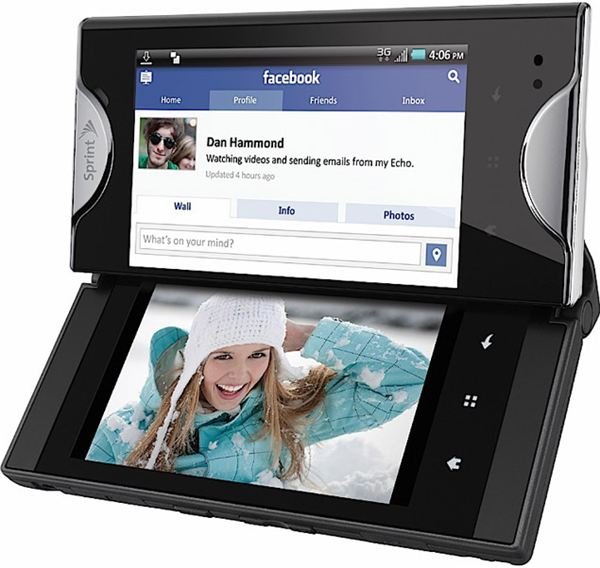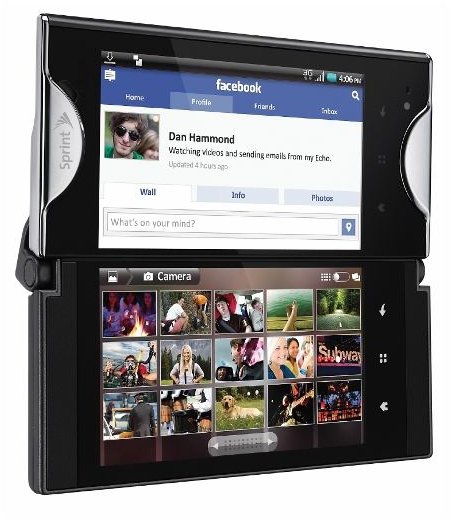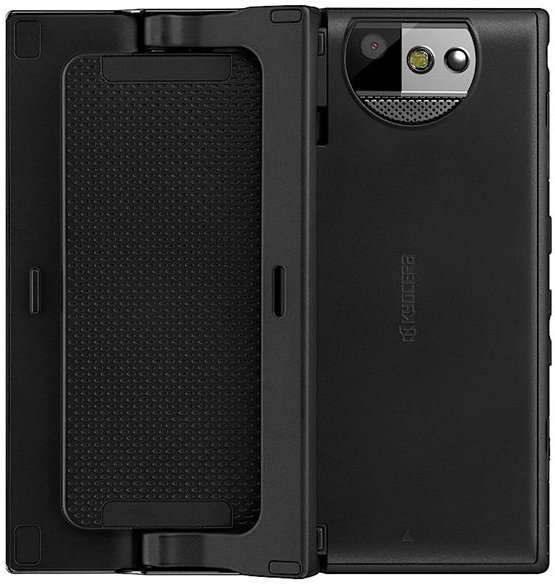Kyocera Echo Review - Sprint's Industry Changing Dual Screen Smartphone
On February 7th, 2011, Sprint unveiled a new smartphone that it was rumored would change the face of the smartphone industry. That particular smartphone was the Kyoecera Echo. Kyocera currently isn’t one of the well known brands in the United States. Samsung, RIM, Motorola, Nokia, and LG are names that come to mind when smartphones are mentioned but Kyocera is very obscure to the current public. It seems that their image will change with the announcement of the Kyocera Echo on Sprint’s network.
The Kyocera Echo is the first ever dual screen smartphone, featuring two screens for use. Unlike the Samsung Continuum, where one display is a small ticker, both screens on the Kyocera Echo can be used. The Kyocera Echo is currently set to be released on Sprint’s network for a reasonable price of $199.99 in the spring of 2011.
Kyocera Echo Specifications:
- Dimensions: .53 x 2.22 x 0.68 inches (115.0 x 56.5 x 17.2 mm)
- Weight: 6.80 oz (193 g)
- Display: Dual 3.5 inch LCD WVGA capacitive touchscreen displays, 480 x 800 pixels
- Memory: 1 GB + MicroSD slot expandable to 32 GB
- OS: Android OS 2.2
- Processor: 1 GHz Snapdragon
- Camera: 5 megapixel camera
- Connectivity: CDMA Dual Band (800/1900 Mhz)
- Data: 1xEV-DO rev.A
- Bluetooth: Bluetooth 2.1, Stereo Bluetooth
- GPS: GPS with A-GPS
- Battery: Li-Ion 1370 mAh
Design and Display (5 out of 5)

Sprint promised that their latest smartphone would change the industry, and the Kycera Echo definitely is designed to look like a smartphone that will change the industry. The Samsung Continuum uses ‘dual screen’ technology, but one screen is actually just a small ticker. The Kyocera Echo, on the other hand, actually features two full screens for use, individually or together. This is an entirely new concept for Android powered handsets and it seems Sprint, along with Kyocera hope that the Kyocera Echo will be the trendsetter.
The Kyocera Echo, when closed, looks like the standard candy bar smartphone, with a 3.5 inch LCD capacitive touchscreen display dominating the front. Below the display are the now familiar standard Android shortcuts for home, menu and back, though it doesn’t have the usual fourth for search. The screen can slide out, similar to a smartphone with a slide out keyboard to reveal yet another screen underneath, with the 3 familiar standard shortcuts underneath the display as well. Fully extend the screen and you have a 7 inch display created by the two dual screens, aiming at competitors in the tablet market, such as the 7 inch Samsung Galaxy Tab. This is an industry first and currently there’s no smartphone out there like it. The display can also be put at an angle to help you use the second screen as a virtual keyboard, somewhat like the HTC 7 Pro but with a virtual keyboard rather than a physical keyboard.
Both displays are vibrant and have fairly decent viewing angles. Once fully extended, the doubled screen size is definitely a welcome treat. Though some may not like the idea of dual screens, for others, the dual screen, “industry changing” concept may be the biggest selling point of the Kyocera Echo.
Hardware and Software (3 out of 5)
The Kyocera Echo, while it packs the wow factor with its innovative design, lacks a bit in the hardware and software department. The Kyocera Echo has a 1 GHz Snapdragon processor, which is similar to other smartphones such as the Samsung Continuum or the Motorola Droid X. In addition, it only has 1 GB of onboard memory, though it does have an expandable microSD slot up to 32 GB, an 8 GB card is included. This is a bit of a disappointment, as there are many smartphones out there that have 16 GB of onboard storage.
In addition, the Kyocera Echo also doesn’t have the hardware to connect to Sprint’s 4G network. The Motorola Atrix 4G on AT&T not only comes with innovative, “industry changing” capabilities of its own, but it also connects to a 4G network. The Kyocera Echo, however, cannot connect to any 4G network, which is a disappointment.
On the software front, the Kyocera Echo also lacks a bit, featuring Android 2.2. With Android 2.3 out, one would hope that many newer generation Android smartphones would feature it, but sadly, like the HTC Thunderbolt, Samsung Infuse 4G and many other upcoming smartphones, it will only have Android 2.2. Hopefully the Kyocera Echo will be upgradeable to Android 2.3 without much hassle.
User Interface (4 out of 5)
Like all Android smartphones, the Kyocera Echo’s user interface is touch based.

With two screens, it means there’s more room to work with, whether it be on one application or two. With the screen slid closed, the Kyocera Echo functions like any other Android smartphone, featuring a home screen and applications. Slide the screen out and you have another screen that can be used for different functions. The Kyocera Echo is set to use the second screen in different manners:
- Simul-Task Mode: Of the 7 core Echo applications, 2 can run simultaneously on the separate screens. Note that not all applications can do this as of now, only the 7 core Echo applications.
- Optimized Mode: Allows the second screen to act as a complimentary screen to the application you’re using. The second screen may act as a virtual keyboard, or as the main browsing screen of YouTube, while the main screen is playing the YouTube video.
- Tablet Mode: Allows both screens to be used as one, making the Kyocera Echo into a 7 inch tablet of sorts.
These different modes are all great additions to the user interface of the Kyocera Echo. One negative is that, currently, the only applications that can be run simultaneously on the separate screens are the core applications that are made for the Kyocera Echo. We will have to wait and see if other applications will be able to run in that mode.
Features (4 out of 5)

The Kyocera Echo, as it runs Android 2.2, features the usual round of Android applications, such as maps, videos, browsers as well as access to the Android Market. This means the Kyocera Echo has access to over 100,000+ applications for use on the smartphone. The seven core applications of the Echo, the applications that can be run simultaneously on the dual screens are: messaging, e-mail, Web browsing, phone, gallery, contacts and VueQue, a video player. This means you can multi-task items and browse the web while watching a video, or call someone while texting another person. It’s like having dual screen monitors on a computer. The sad part being that it’s only for those 7 core applications at the moment.
The Kyocera Echo also comes with a 5 megapixel camera, with autofocus and flash. This seems to be the standard with most smartphones, and it is a bit disappointing that there was no front facing camera. It would have been a great feature to allow video chatting on one screen while you’re typing on another. Sadly, the inability to connect to the 4G network most likely nixed the idea of adding any front facing camera.
The 5 megapixel camera on the back looks to be decent and can also record video at 720p. Once again, the video recording seems to be at the level of the standard higher end smartphone. Other smartphones such as the Samsung Vibrant capture 720p video well and one can only expect that the Kyocera Echo won’t be any different.
The Kyocera Echo will also be able to extend its 3G to other devices at a price. For an additional $29.99, the Kyocera Echo will be able to act as a mobile hotspot, being able to support up to 5 Wi-Fi devices. The only item to note is that it’s sharing Sprint’s 3G network, not WiMAX, which is currently Sprint’s 4G network.
The Final Verdict (4 out of 5)
Sprint lauded the Kyocera Echo as the “industry changing” smartphone of 2011, but upon closer inspection, that may not be the case. While it is an innovative design, Sprint and Kyocera haven’t gone far ahead enough to really make the Echo a forward thinking smartphone. The dual screen is a great addition, but Android can’t really support the two screens yet. The user is limited to 7 applications specifically for the Kyocera Echo. In addition, there’s no access to a 4G network, which seems to be the big rage after the 2011 Consumer Electronics Show. The Kyocera Echo therefore ranks in as a solid ‘Good’ smartphone, but one has to wonder how long it will last. It may quickly end up being a flash in the pan, becoming a smartphone that had a “cool idea” but not enough innovation to keep it in people’s minds.
References
- Source: Author’s experience
- Image Credit: Uncrate.com, https://www.uncrate.com/men/images/2011/01/kyocera-echo.jpg
- Image Credit: BusinessInsider.com, https://static2.businessinsider.com/image/4d5083d1cadcbba30a0e0000/kyocera-echo.jpg
- Image Credit: SoftSailor.com, https://cdn.softsailor.com/wp-content/uploads/2011/02/Kyocera-Echo-Back-Close-up.jpg